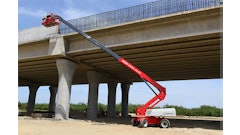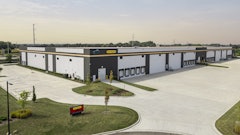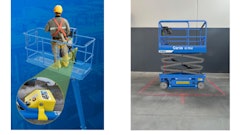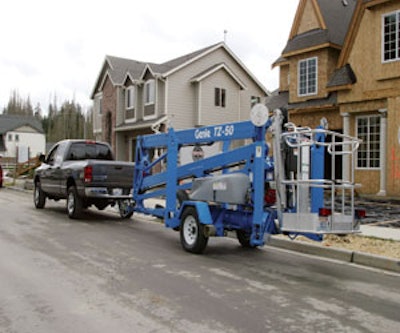
For a price tag that ranges from 30% to 50% less than a self-propelled boom lift, you can acquire a towable boom that rivals the self-propelled models in terms of utility.
There are towable boom lifts in existence that can reach as high as 100 ft., but most available in the U.S. market range from 35 to 60 ft. They generally come in two types: articulated knuckle booms and telescopic booms. Knuckle booms are the most popular because they offer versatility in places they can reach. With a knuckle, the boom can get close to the structure and then reach over it, whereas telescopic booms are limited to just reaching up.
Towables are priced as low as $25,000, making them an affordable option for those not prepared to invest upwards of $75,000 for a self-propelled lift.
"The initial acquisition price for towable boom lifts would be lower than a comparable platform height self-propelled boom lift primarily due to their not being equipped with the very expensive drive systems that are representative of today's self-propelled boom lifts," says Mark Mohn, product manager - boom lifts with JLG Industries Inc. "Towable boom lifts do have optional drive systems, but these would be to deliver more basic drive and grade requirements.
"Towable booms are for lighter-duty applications than typical self-propelled booms and have a limited drive capability when optionally equipped," he continues. "Self-propelled booms generally have larger platforms to allow multiple workers in the platform, while towable booms are more typically for one-person operations."
One reason for the appeal of towable booms is their ease of transport. "No special carriers are required. Your personal vehicle outfitted with a trailer hitch (as many pickup trucks and SUVs are now purchased) with a minimum towing capacity of 3,000 lbs. will get [them] on the road," explains Mohn.
Another aspect to towables is the simplicity of the controls. As Mohn notes, fewer machine functions facilitates training for new operators.
Lightweight and level
While they're easy to transport, towable booms are not made to move around a jobsite with the boom extended, as are their self-propelled cousins.
"You can't drive towables while up in the air," says Alastair Robertson with Niftylift, which has been making towable boom lifts since 1981. "Most towables today offer a [drive and set] arrangement so the operator can walk behind or drive the machine from the platform in the stowed position."
Because they can't be driven with the boom extended, towables are not designed for every application. "It takes more time to move the machine a lot," says Brad Dilling, product manager at Genie Industries. "You have to keep coming down and going back up."
Towables are, however, ideal for applications where vehicle weight is a concern. "The platform on towables is made of aluminum, whereas on self-propelled models, it's steel," says Dilling. "This is done to keep the weight down."
Robertson notes that a 40-ft. self-propelled boom typically weighs somewhere in the neighborhood of 10,000 lbs. Towables, on the other hand, hover around the 3,000-lb. mark, enabling them to work on the upper levels of structures where a lot of weight is undesirable. They are also less damaging to turf, so landscape professionals can operate them with less fear of disturbing lawns or flower beds.
One way that towables achieve a lighter weight is through the use of outriggers as opposed to counterweight, which provides self-propelled models with the stability necessary to rise to high heights. As a result, a towable's footprint is larger, usually about 14 ft. across. Despite the wider wingspan when in use, towables can fold up to just 3 ft. 6 in., making it possible for them to fit into tight spaces such as backyards and around buildings.
In addition, says Mohn, "The outriggers offer a leveling capability and a firm lifting base of operations that is beneficial in areas of great land undulation."
Dilling agrees, noting that Genie towables can level themselves on up to an 11° slope, while most self-propelled booms have a 2 1/2° slope capability.
A question of stability
If their light weight and leveling capability are defining characteristics of towable boom lifts, the next question to follow is often, "How stable are they?"
According to Robertson, towables are just as stable as self-propelled boom lifts. They are required to meet safety standards just like self-propelled models. It's the perception of stability that is sometimes in question. "When you're up in the air, you don't look down on a big base beneath you, but you have a 14-ft. spread from the outriggers," he notes.
Still, as Dilling points out, operators might notice a different "feel" when using a towable as opposed to a self-propelled unit. "There's a bit more deflection, so the boom might feel a little softer," he says. This deflection, or slight movement of the boom when extended, is due to the use of lighter materials. Because self-propelled units are not restricted in terms of weight, the booms can be constructed to be a bit more stiff. This is sometimes perceived to be more stable, when in fact, there is no technical difference in stability.
What to look for in a towable
Towable boom lifts today offer many of the same basic features, such as drive and set systems, self-leveling hydraulic outriggers and towing speeds up to 65 mph. The main difference between brands is often after-sale support.
"It's important to choose a reputable manufacturer that will support the product with training, parts supply, etc.," says Mohn. Other factors to consider include the design of the machine. Is it rugged enough to hold up to the rigors of over-the-road transport? How are the "feel" of the platform controls and the outrigger deployment system?
Power options are another area to think about when choosing a towable. Some models are electric, which makes them ideal for indoor use, and some are gasoline powered. There are also bi-energy models that combine the best of both worlds and make it possible to perform more applications with just one machine.
Whatever model you choose, it's crucial that you educate your employees about safe operation.


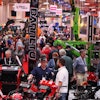
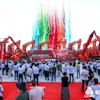




![Building Angled Sm Edit 6050b8d213f1b[1]](https://img.forconstructionpros.com/mindful/acbm/workspaces/default/uploads/2025/09/building-angled-sm-edit6050b8d213f1b1.Ygq5aAos3b.png?ar=16%3A9&auto=format%2Ccompress&crop=focalpoint&fit=crop&fp-x=0.53&fp-y=0.23&fp-z=2&h=135&q=70&w=240)
